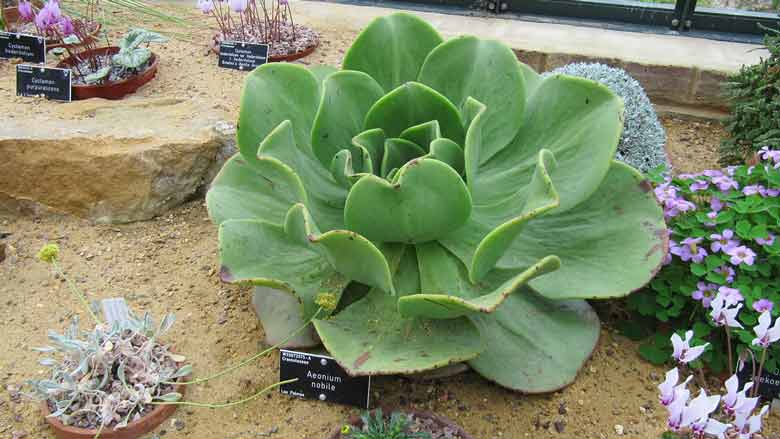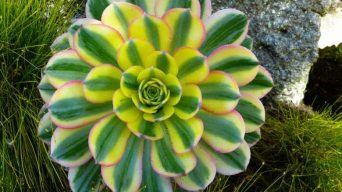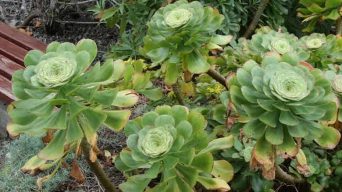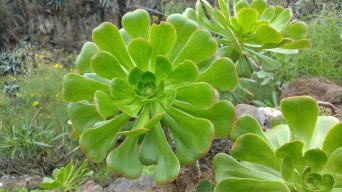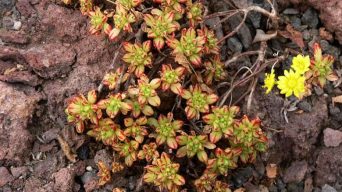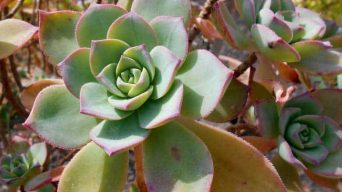Aeonium nobile succulents are beautiful, easy-to-grow plants that can be a great addition to any garden.
They are a rare type of Aeonium, growing in a rosette shape.
This article will teach you everything you need to know about caring for Aeonium nobile plants so that your plant grows healthy and strong!
Overview
| Family: | Crassulaceae |
| Genus: | Aeonium |
| Botanical Name: | Aeonium nobile |
| Synonyms: | Megalonium nobile, Sempervivum nobile |
| Common Names: | Noble aeonium |
| Origin: | The island of La Palma in the Canary Islands |
| USDA Hardiness Zones: | 9 – 11 |
| Size: | 1 to 2 feet tall (30 – 60 cm) and 12 to 15 inches (30-38 cm) wide |
| Sun Exposure: | Full sun to partial shade |
| Water Needs: | Water thoroughly but infrequently |
| Soil Type: | Well-draining soil |
| Temperature: | 65° to 70˚F (18°-24˚C) |
| Humidity Levels: | 40-50% |
Aeonium nobile, also known as the ‘Noble Aeonium’, is a flowering plant native to the Canary Islands.
The Aeonium species is a member of the Crassulaceae family and has several varieties that are also endemic to the Canary Islands, such as:
- Aeonium undulatum
- Aeonium canariense
- Aeonium tabuliforme
- Aeonium leucoblepharum
- Aeonium ‘Sunburst’
Aeonium nobile is a succulent plant that grows large rosettes of fleshy green leaves, sometimes variegated with reddish or brown colors.
Noble Aeonium rosettes grow up to 15 inches in diameter on average. The leaves are up to 2 inches long and up to 1.2 inches wide.
The Aeonium nobile succulent plant produces a large inflorescence that rises on a red stalk with many small red star-shaped flowers in late winter to early spring.
This Aeonium variety only flowers once before it dies.
How To Care for Aeonium Nobile ‘Noble Aeonium’
Aeonium nobile care is a relatively straightforward process for beginner gardeners and succulent enthusiasts.
Below you will find the main aspects to consider when caring for an Aeonium nobile succulent.
Sun Exposure & Light Requirements
The Aeonium nobile plant requires full to partial sun exposure to grow a healthy, vibrant plant.
When aeoniums are grown in a shady or partially shaded environment, they tend to lean toward the light source and become leggy with spindly branches.
Eventually, this leads to poor growth because less sunlight reaches the lower leaves, vital for photosynthesis.
The Aeonium nobile succulent plant does best when grown outdoors.
When Aeoniums are grown outdoors, they should be planted where they will receive about four to five hours of sun exposure daily during the summer and two to three hours per day in the winter.
If Aeoniums are grown indoors, they still need a fair amount of sun exposure. Artificial lighting will not be enough to grow a healthy plant because the light is too intense and doesn’t provide the same spectrum as natural sunlight.
They should be located near a south-facing window when grown indoors so they get a minimum of six hours a day in natural light.
Watering Requirements
Aeonium nobile is a succulent that does not need a lot of water and prefers a dry environment.
It should only be watered when the soil has completely dried out and no more than once a week during the summer months.
During winter, it can go as long as two weeks without water; however, you must always check the soil before watering, as a dry environment is preferred for this succulent.
In addition to its low water requirements, Aeonium nobile is also sensitive to overwatering.
The best time for watering is in the morning or evening so that they receive a good night’s rest. However, this can vary depending on your climate and weather.
You should note that these plants will do just fine with only one thorough watering every two weeks during winter (this does not apply when it is hot).
Soil Requirements
Aeonium nobile succulents are cactus-like plants which means they need a soil mixture that is porous and well-drained. You can achieve this by using a light potting mix for succulents or adding sand to a regular potting mix.
If a potting mix is used, a soil mixture should be created using a combination of peat moss and vermiculite or perlite.
Aeoniums can also grow in a standard potting mix as long as it has been amended with more sand than usual, mainly if the plants are being grown outdoors where there may not be good drainage.
A cactus/succulent mix is also an excellent potting mix.
Temperature and Humidity
Aeonium’s natural habitat is a dry, sunny rock outcrop in a hot and arid climate. A warm, dry climate and a sunny location will be necessary to properly care for an Aeonium nobile.
The ideal temperature for an Aeonium nobile plant should be between 18°C – 24°C (65°F-75°F).
The plant also prefers a relative humidity of 40% to 50%. You should keep the Aeonium nobile in a bright, well-lit area.
Fertilizing
The Aeonium nobile is not a heavy feeder and will be fine with one fertilizer application per year, spaced out evenly during the watering cycle.
However, if you want it to thrive, fertilizing twice or three times a year would be beneficial.
You can use a half-strength balanced fertilizer a couple of times a year or a full-strength balanced fertilizer once a year.
Apply the fertilizer at about one teaspoon per gallon, then water it as usual.
Potting and Repotting
Potting Aeonium nobile is a simple process.
First, put the Aeonium into a pot at least twice as deep and wide as it was in its previous container if you’re transplanting from another pot.
Ensure the drainage holes on the bottom of your new planter are not too high for water to flow out easily.
Fill with well-drained soil mix until it’s firm to the touch, but there is still some room for more (a little less than halfway).
Gently set your plant down so no extra dirt falls off.
Then fill any space with soil and pat down firmly all around using both hands, pushing down while turning slowly in each direction like kneading a ball of dough.
Aeoniums need a potting mix that is very loose and porous, making it easier for their roots to breathe and drain well.
If you’re planting a new Aeonium in your garden or flower bed, make a hole at least a couple of inches deep and wide, then fill it with a mix of half soil and half sand.
Once you have the Aeonium planted in either a pot or garden bed, water well so that there is no dry patch on top of the dirt before leaving for a few hours (or overnight).
Pruning
The Aeonium nobile does not require regular pruning, as a well-grown plant will have a natural, unruly shape.
It is only necessary to remove any dead or damaged foliage in the spring and summer seasons.
Do this by cutting off with a sharp pair of garden shears at a 45-degree angle just above a lower leaf node on an established branch.
Be careful when pruning out old leaves, as a new leaf may take a long time to grow.
It can also be helpful to remove old foliage that has turned brown to allow light into the plant’s interior. However, this should not happen too often, as Aeoniums are a very slow-growing plant.
Pests and Diseases
One of the biggest problems with Aeonium nobile plants is their susceptibility to various pests and diseases.
Fortunately, most Aeonium plants are not a pest magnet or disease-prone.
The best way to combat any potential issues is prevention.
- Keeping your Noble Aeonium on the dry side will help prevent mildew from forming and keep mosquitoes away from it too!
- When choosing where to place your plant, ensure plenty of air circulation around it, which also helps ward off pests such as spider mites and bugs.
- Aeonium plants also need a lot of sun, up to 12 hours a day if possible! Be sure you’re not placing it where trees or buildings will shade the plant, as this can lead to more problems, such as leaf scorch and stem rot.
- Avoid overwatering when watering plants like Aeonium nobile, as wet soil is an environment that’s perfect for growing pests and disease spores.
How to Care for Aeonium Nobile in Winter
Aeonium nobile winter care is a little different from summer care.
They do not handle cold well, so more care is needed in the colder months.
The Aeonium plant needs a winter soaking every month or two, depending on where you live.
Watering should be lighter in the colder months because it will not evaporate quickly and does not need to hydrate so much due to cooler temperatures outside.
You can also water less frequently, like once a week, if your plant is going dormant for a few weeks during the coldest part of winter.
Also, when the temperatures drop a lot, aeoniums need a little more light. This includes a few hours of bright light during the day and at least three or four last for a couple of weeks before spring comes around again.
When frost starts to show on Aeonium leaves, bring the plant inside.
A warm south-facing window will help keep frost from forming, and a few hours of bright light a day is perfect too.
You can also wrap your Aeonium in a sheet or blanket during cold nights for added insulation if you need to take it indoors temporarily due to an unexpected hard freeze.
How To Propagate Aeonium Nobile
Noble Aeonium is a succulent plant that is commonly used as a houseplant. It’s also a beautiful focal point in a garden setting.
This guide will teach you how to propagate an Aeonium nobile from leaves, cuttings, or seeds.
From Leaves
The first way to propagate this beautiful succulent type is by taking off a leaf and treating it like a cutting (leaves produce roots).
Take the end of the stem where it meets with the leaf, and push down along either side of the petiole until one end breaks free.
Allow the fleshy leaves to callous for a few days and then bury up to about half an inch below ground level.
Keep soil moist but not wet for best results. You can also use a rooting hormone if desired–but they’re unnecessary.
From Cuttings
To take a cutting from an Aeonium, remove a leaf by taking it off at the base of where it meets with the stem.
Remove as much of the petiole as you would for a regular houseplant to discourage rot, and then allow it to callous (usually about a week).
After that point, place in moist soil up to half an inch deep or less if preferred. Keep soil constantly wet until roots form–about six weeks total.
From Seeds
This is one of the easiest ways to propagate your Noble Aeonium plants!
Sow a few seeds in a container with light, sandy soil, and water daily. This will grow into a mass of plants you can separate after six weeks–a perfect time to move them outside!
You’ll notice the plant begins budding at this point.
Is the Aeonium Nobile Toxic?
The Aeonium nobile is not toxic to pets and humans but contains a sap that may cause skin irritation.
It is always a good idea to wear gloves while handling Aeonium plants.
Final Thoughts
The Aeonium nobile succulent plant requires very minimal care or maintenance. This makes them an excellent beginner’s choice for those who want something low-key that won’t require much time commitment from their gardener.
With proper care, the Aeonium nobile will thrive and reward a gardener with a long-lasting, beautiful succulent.

